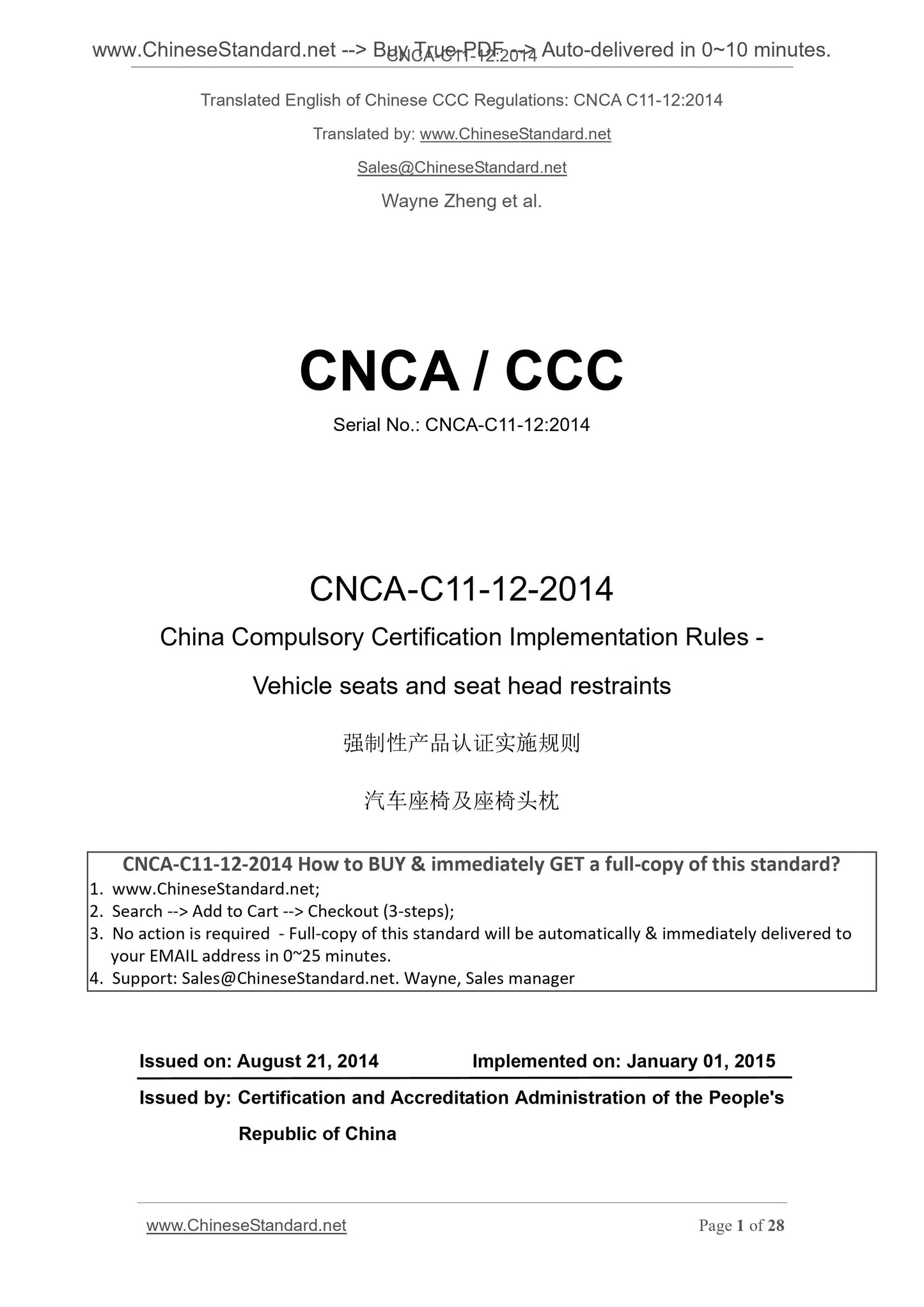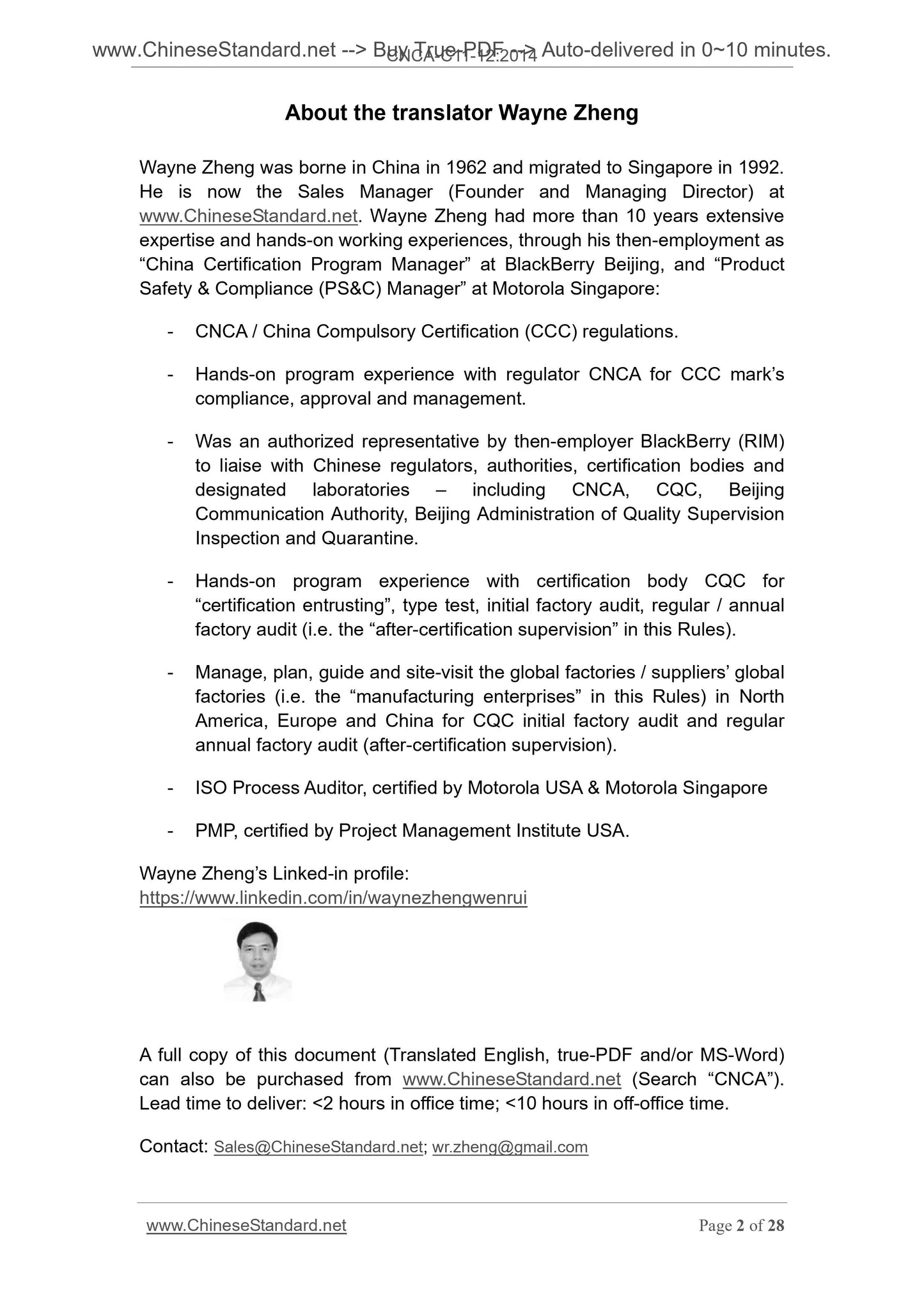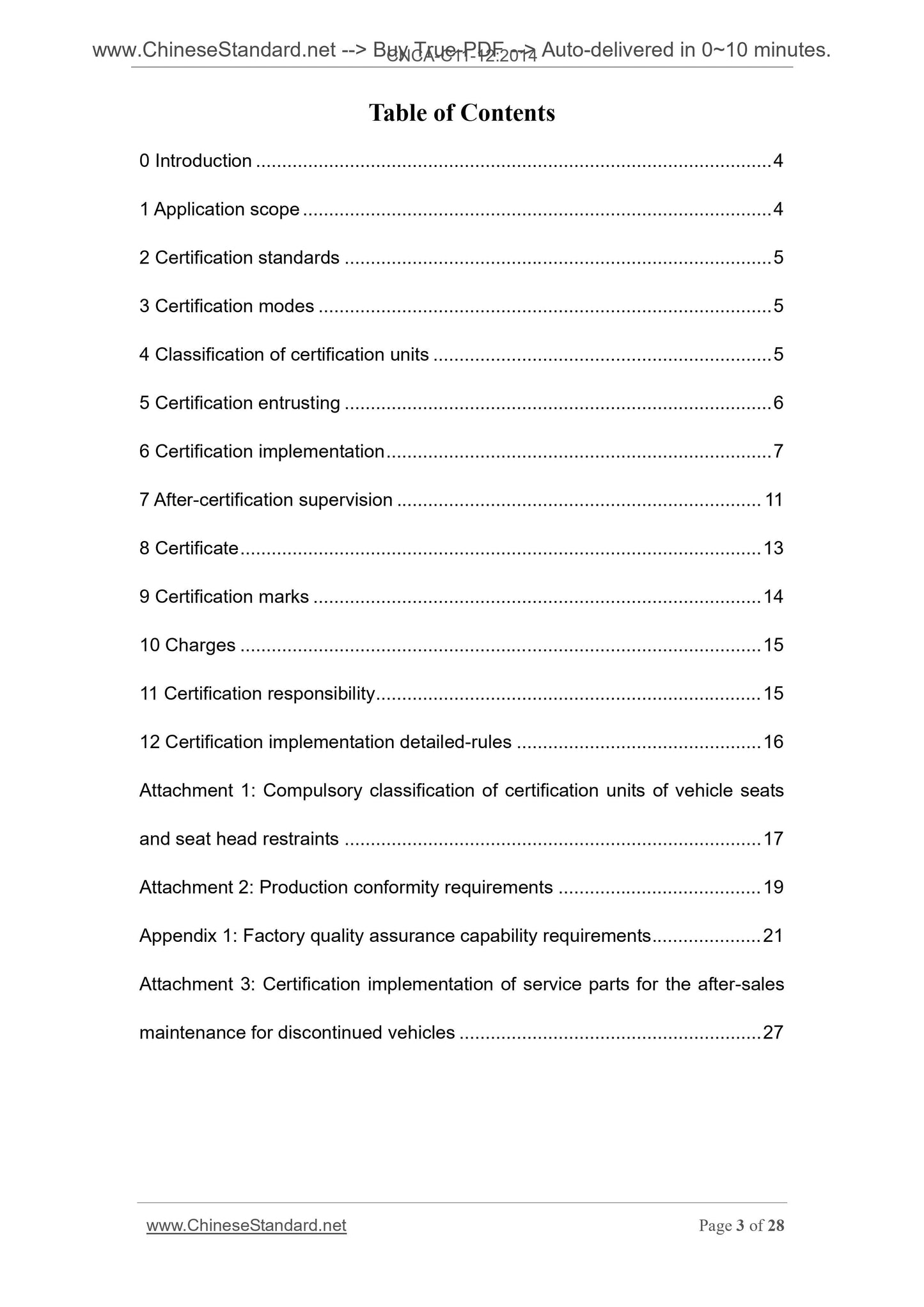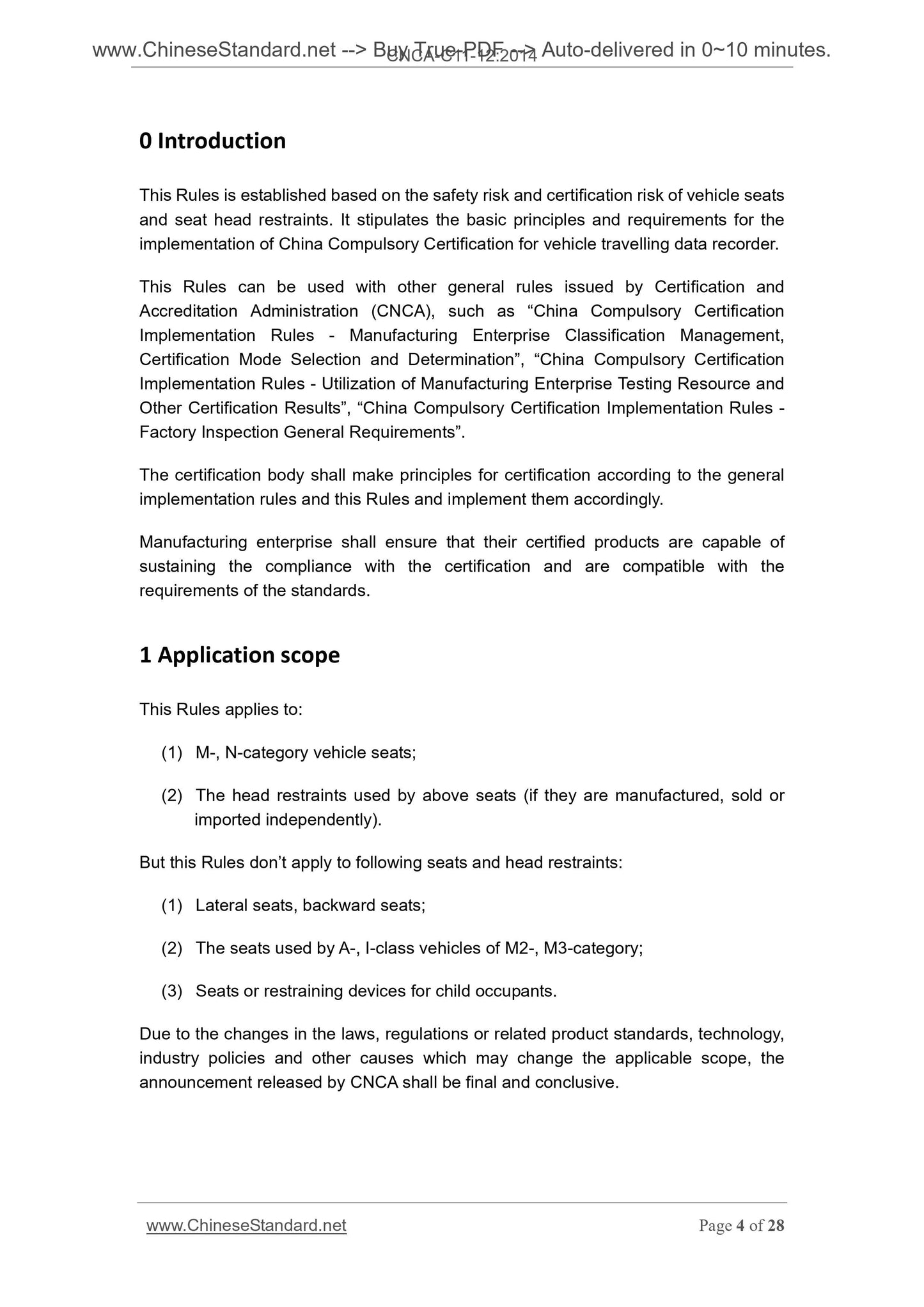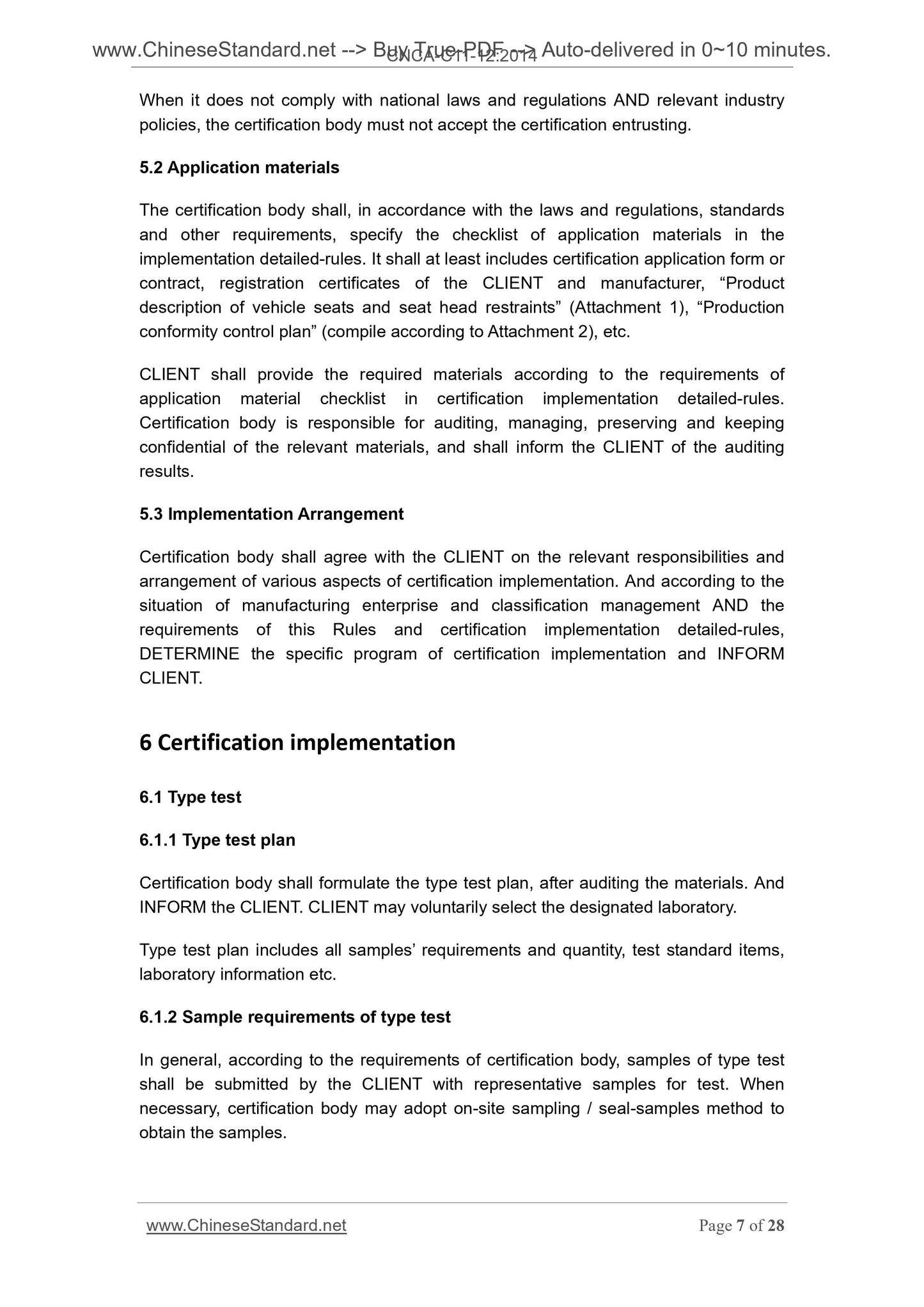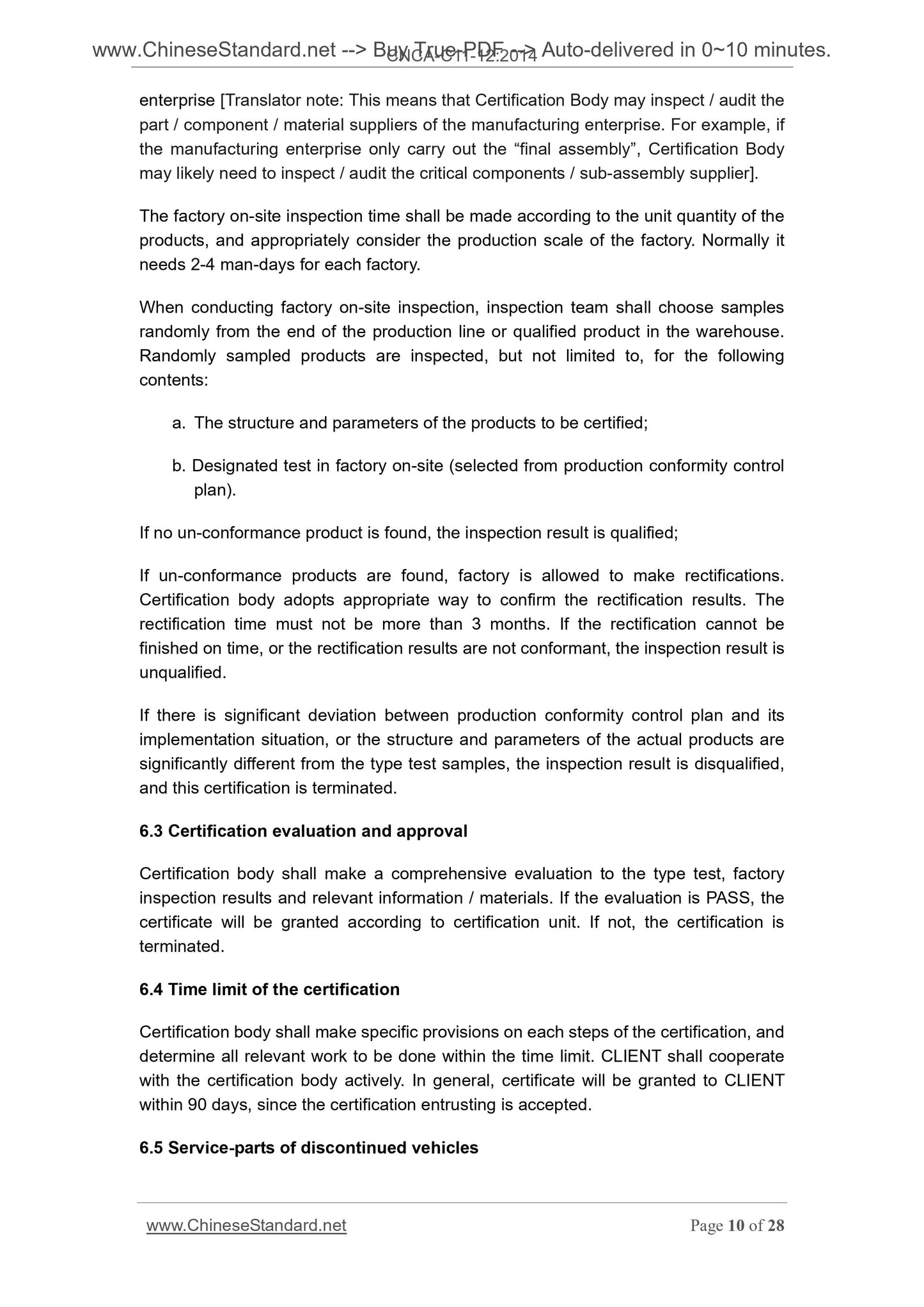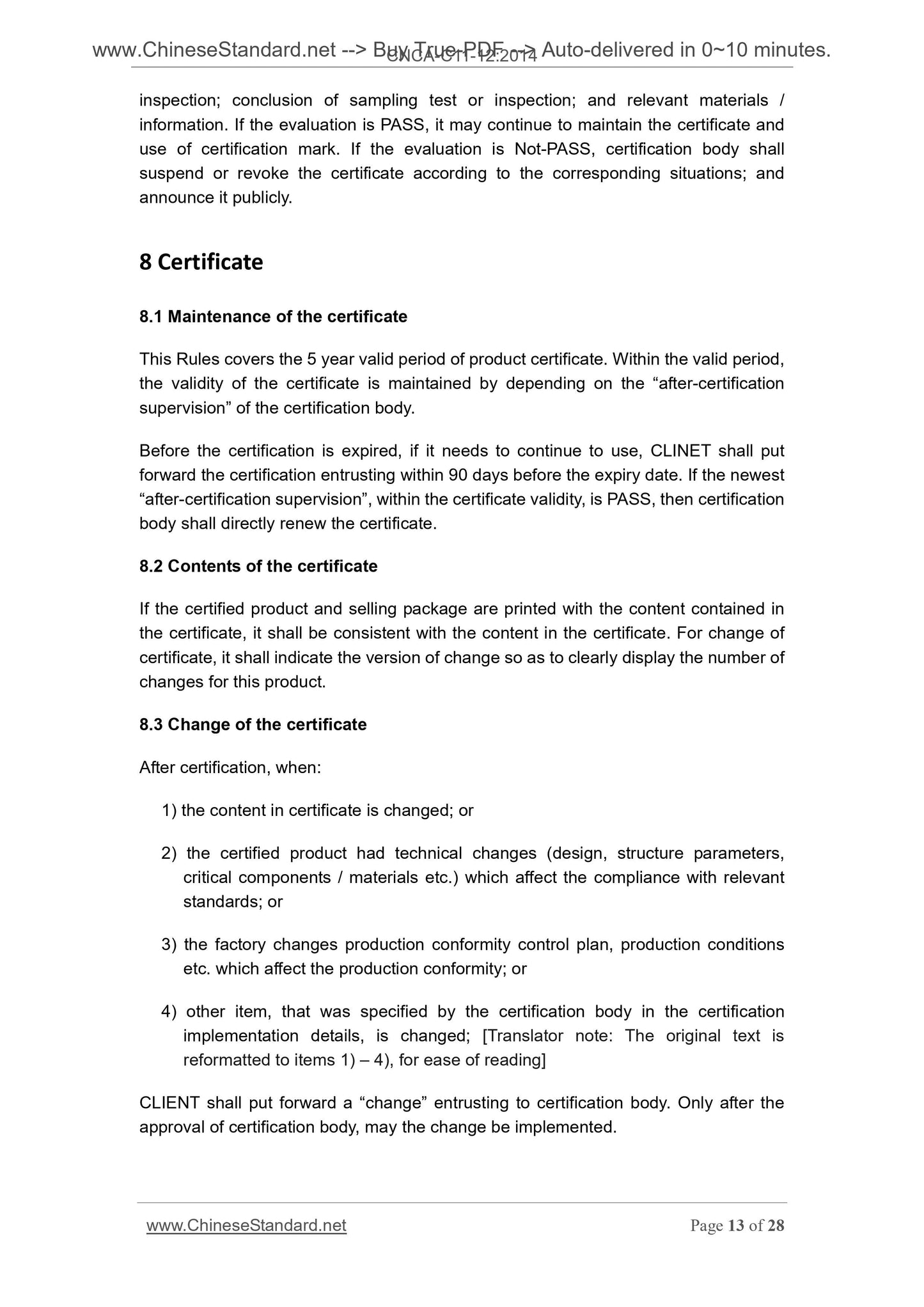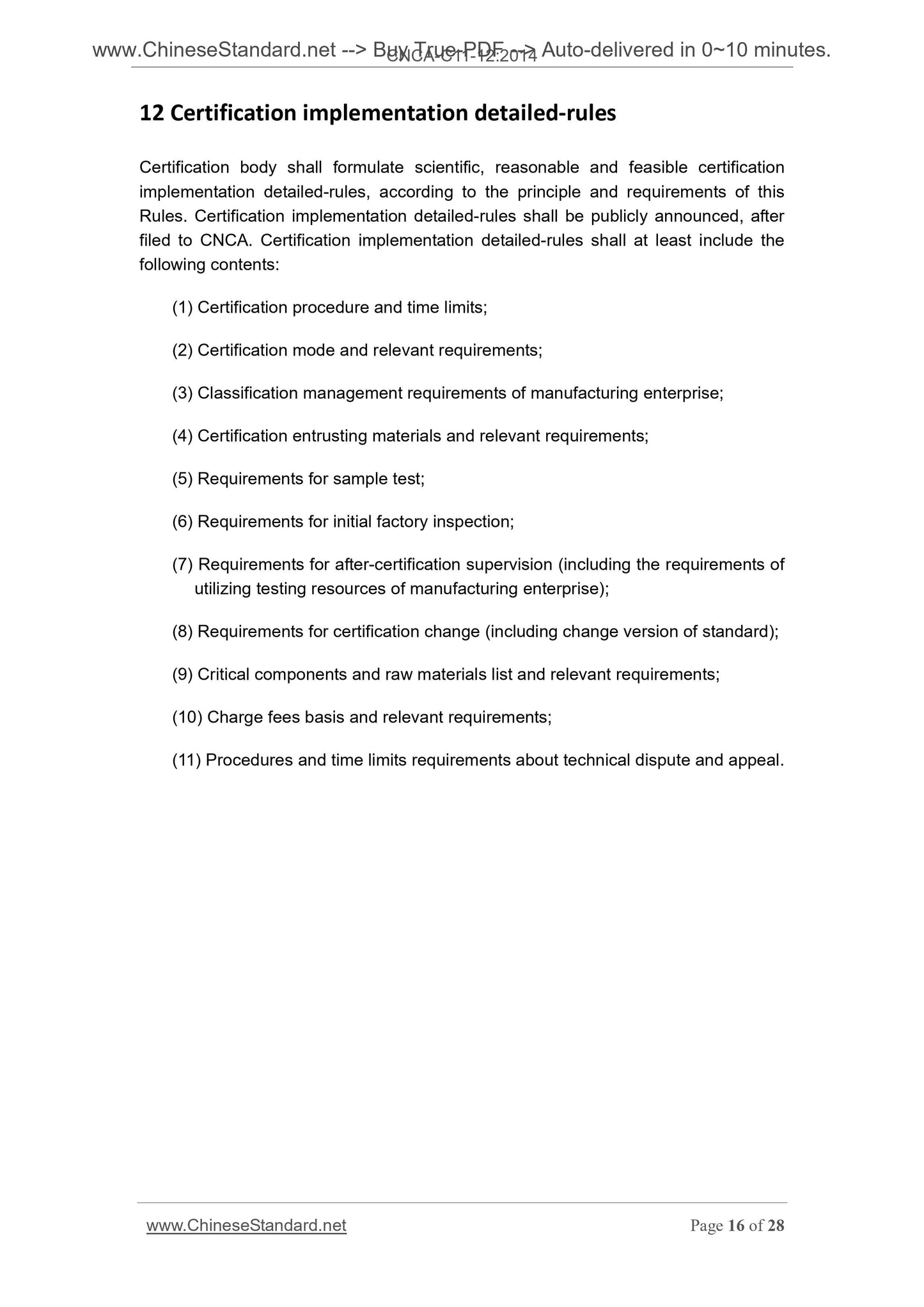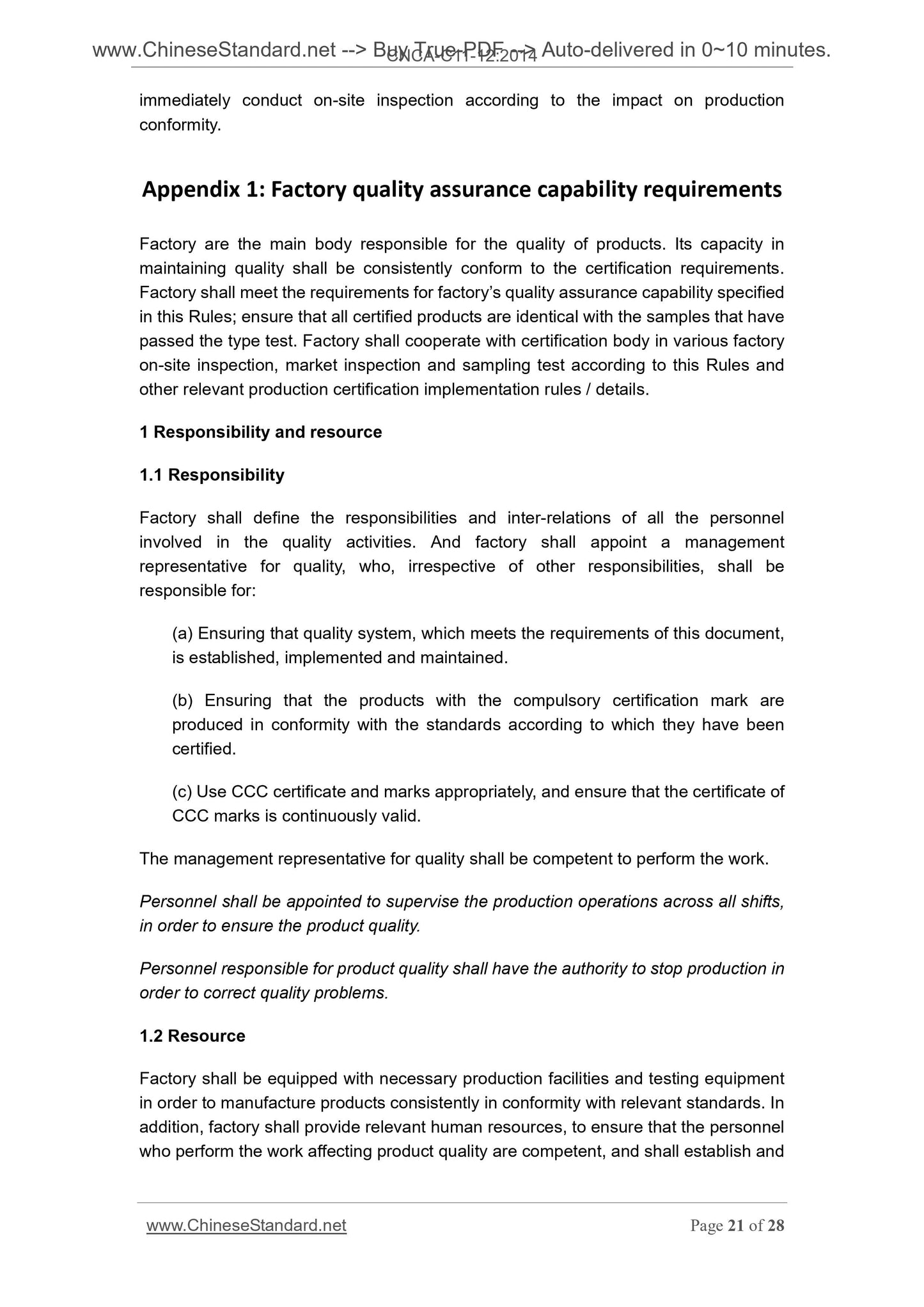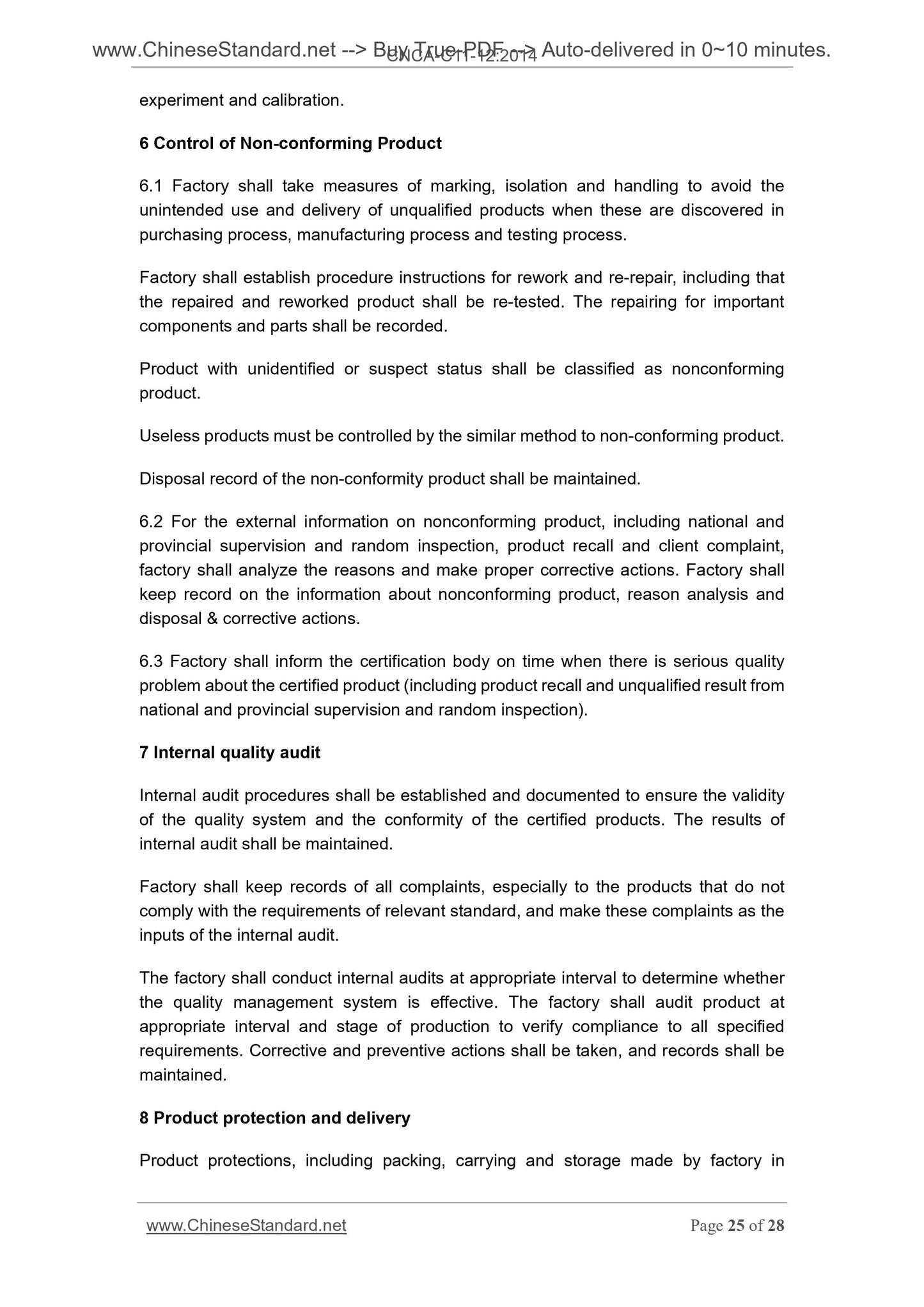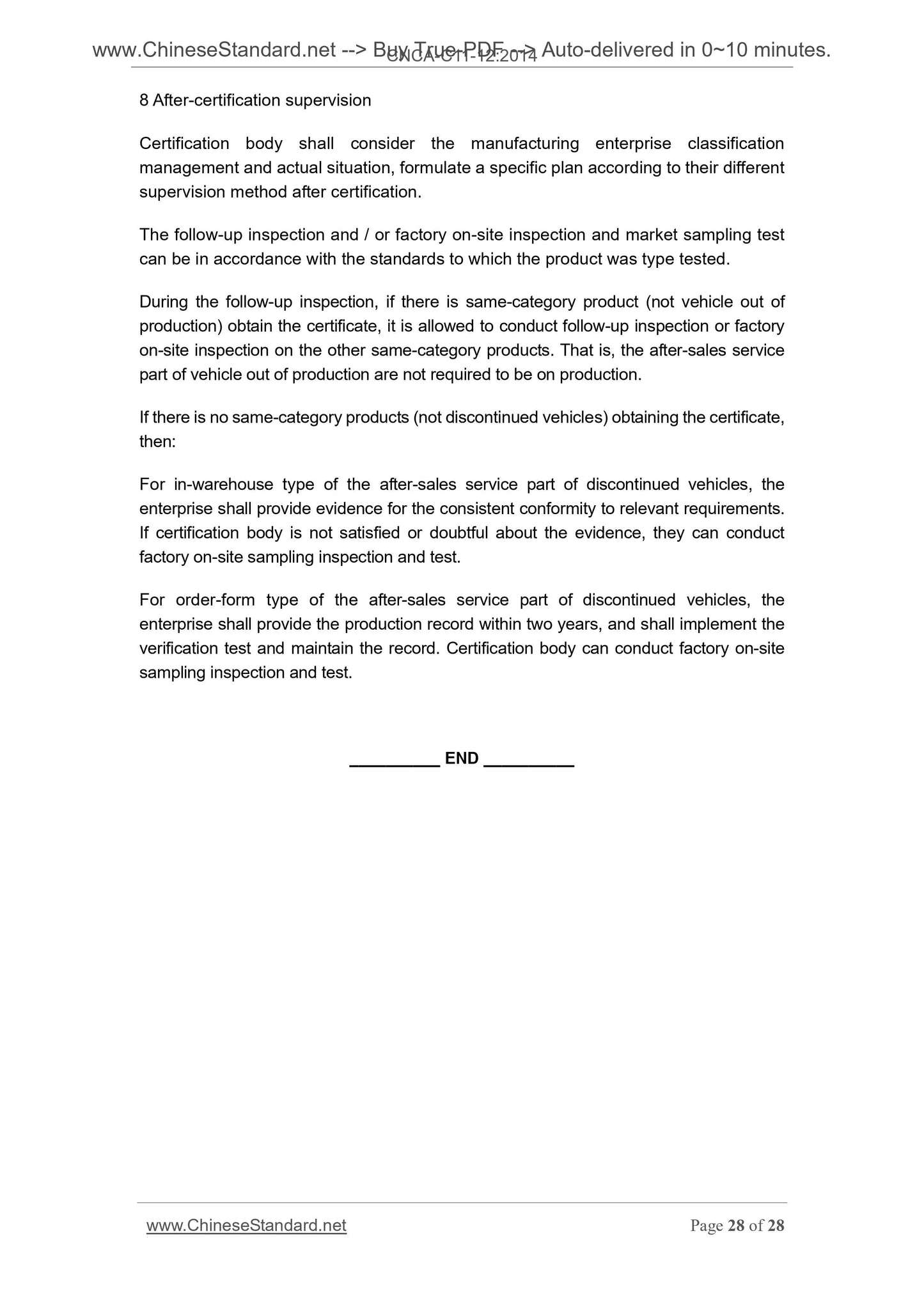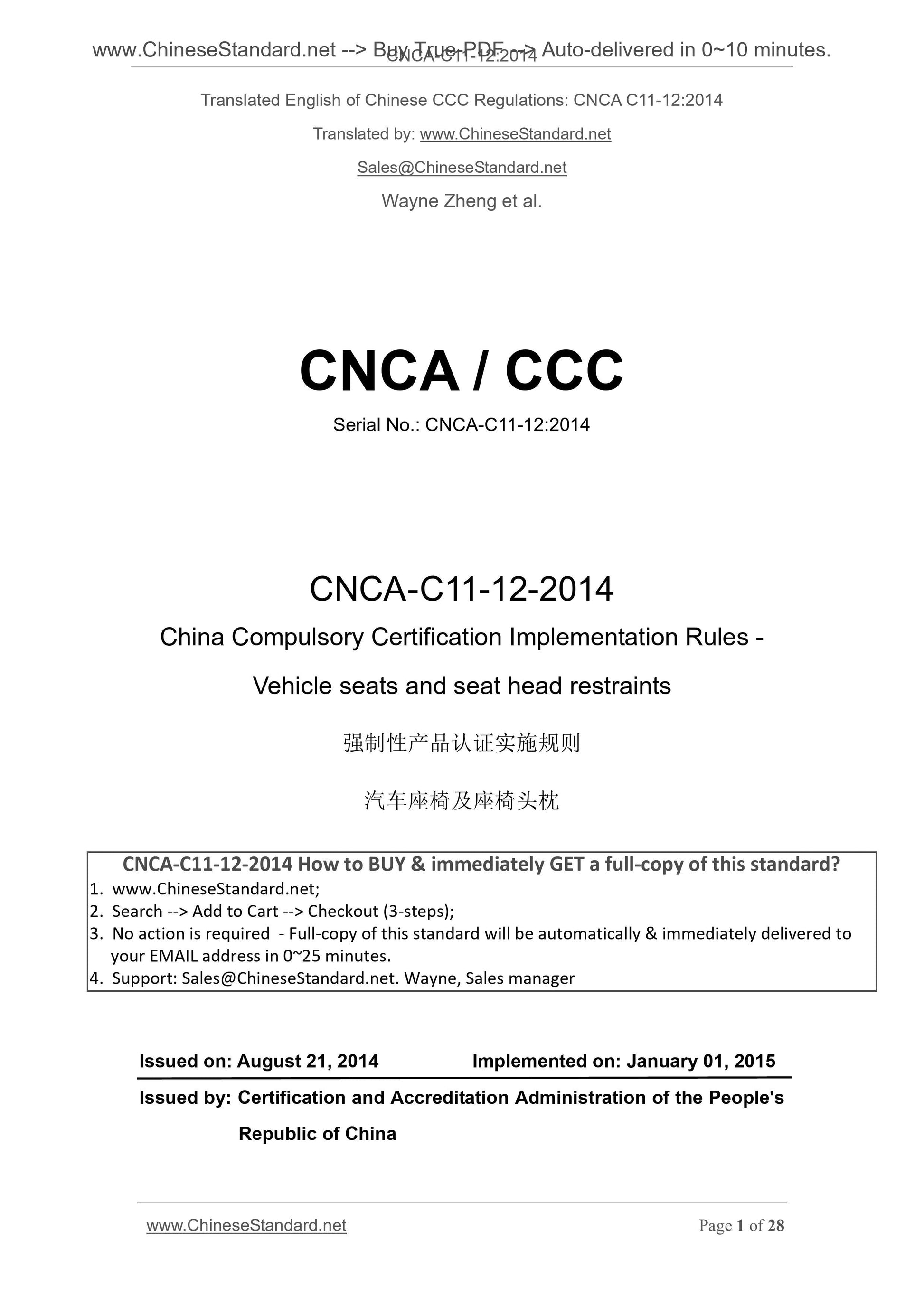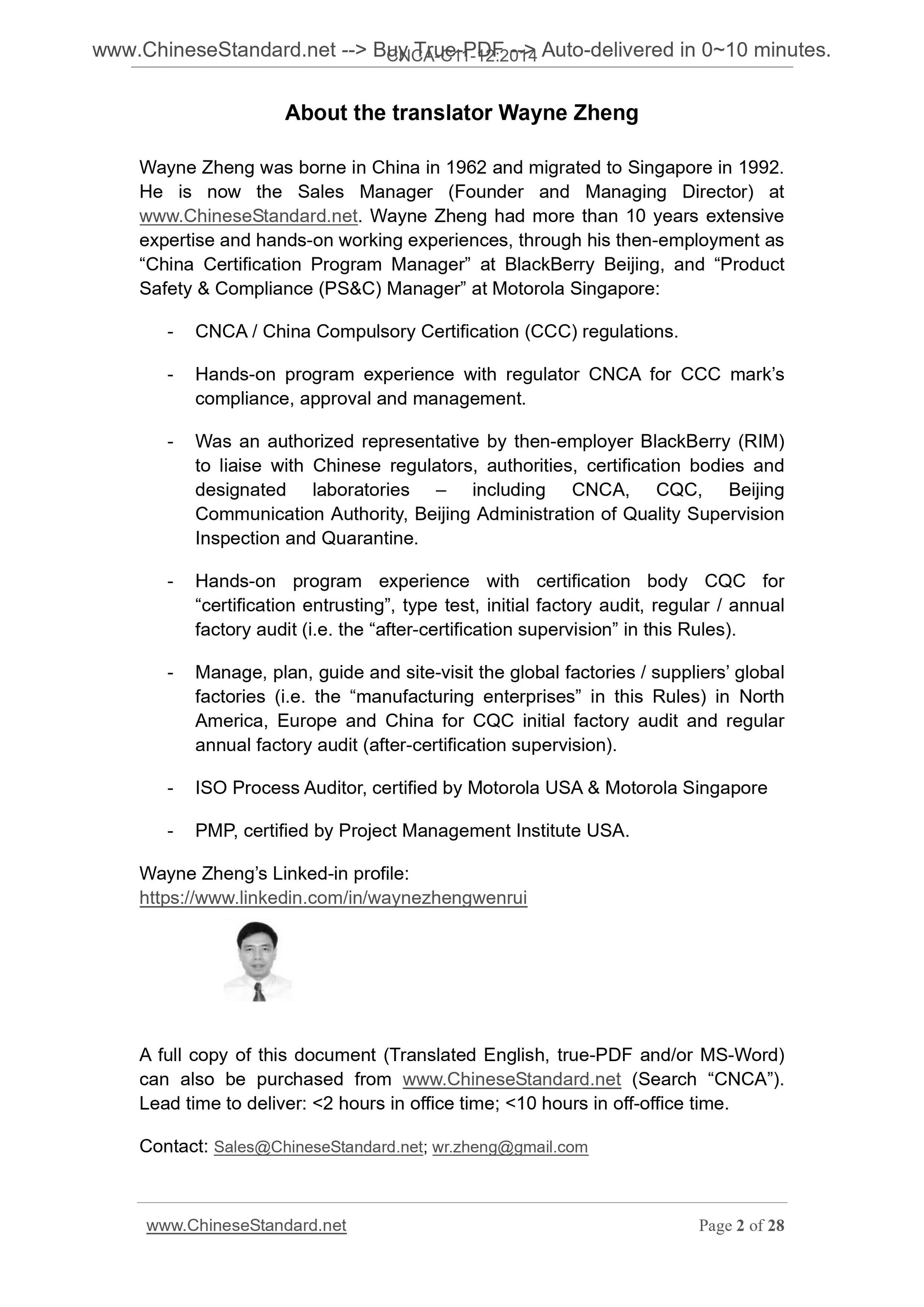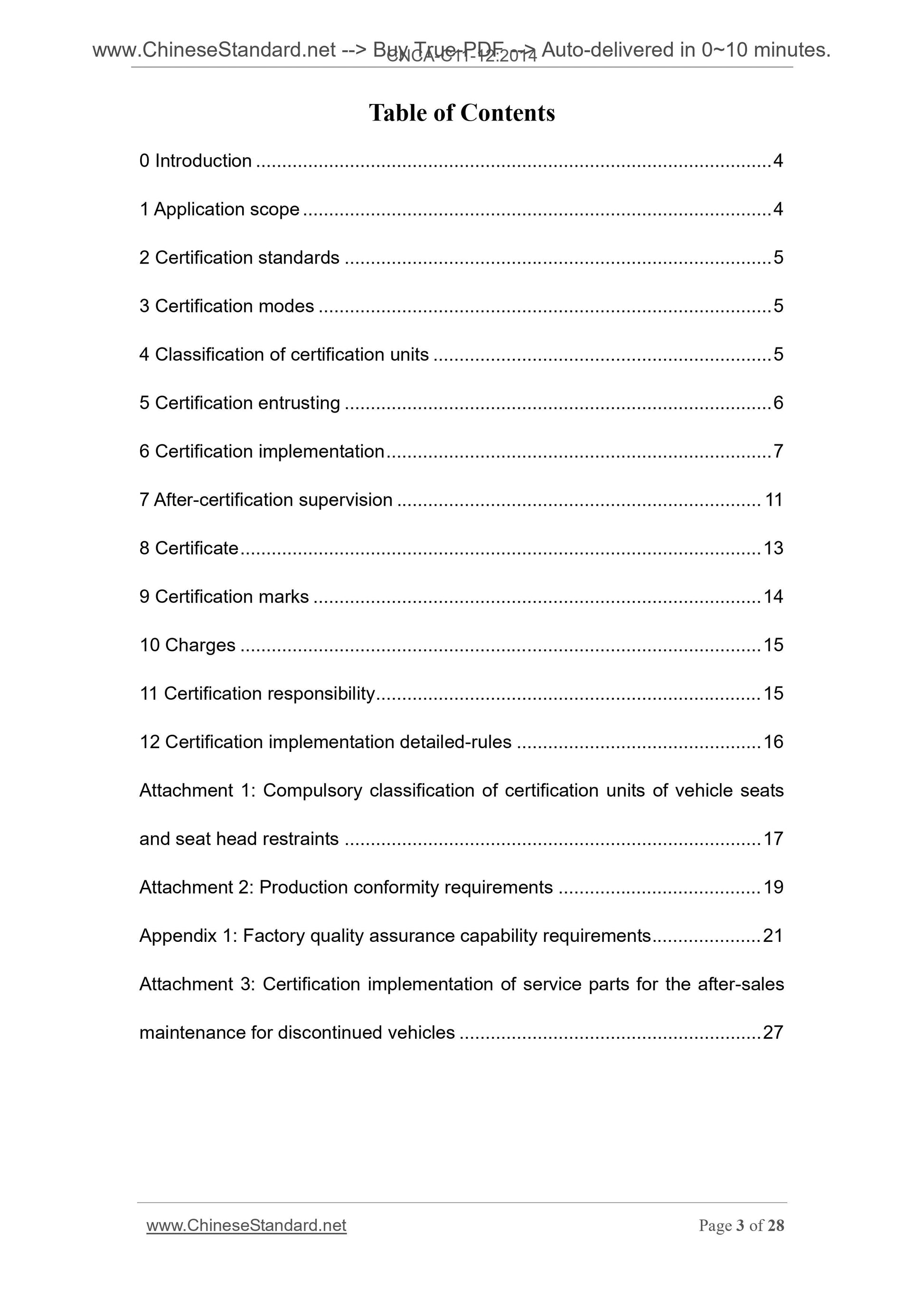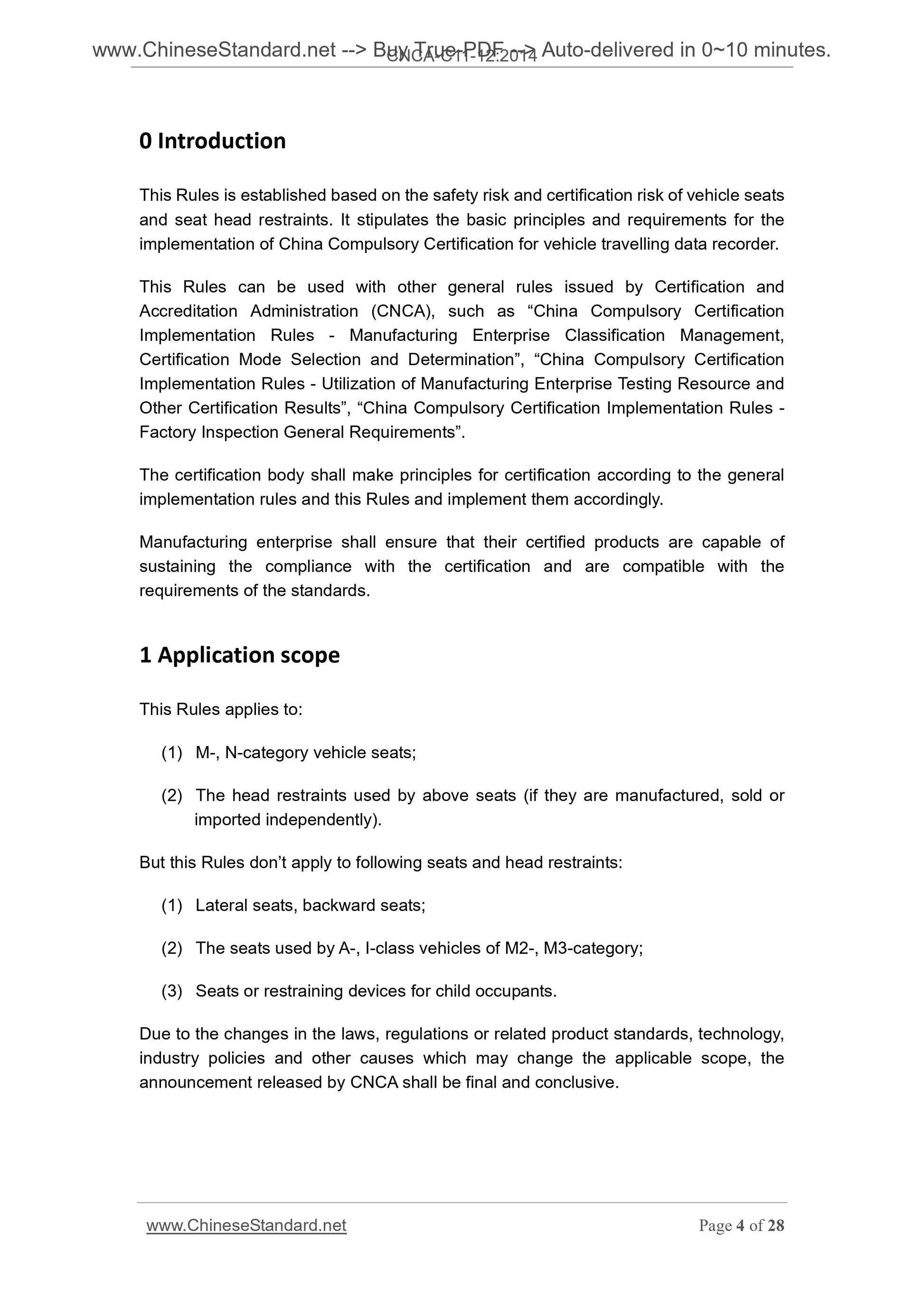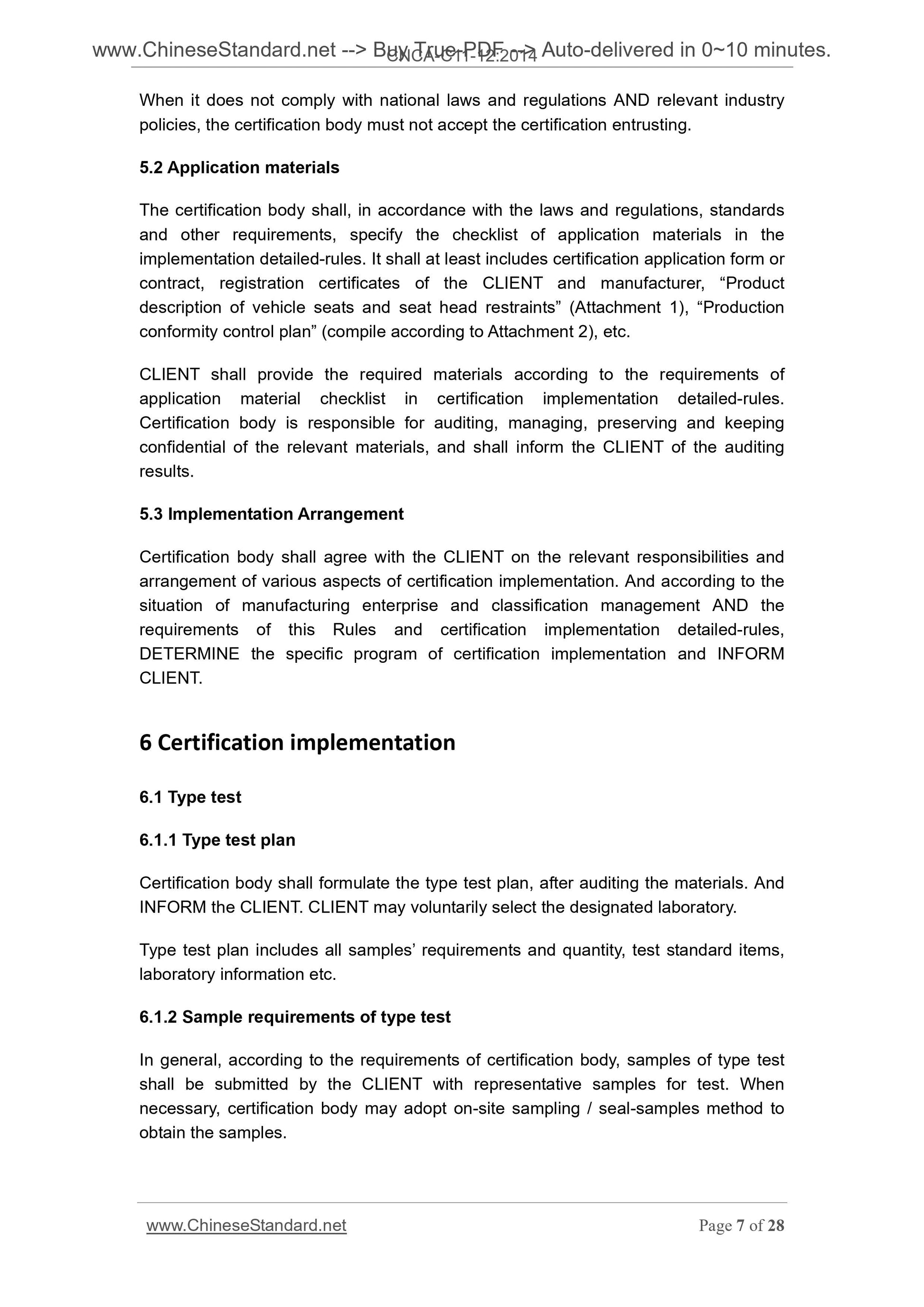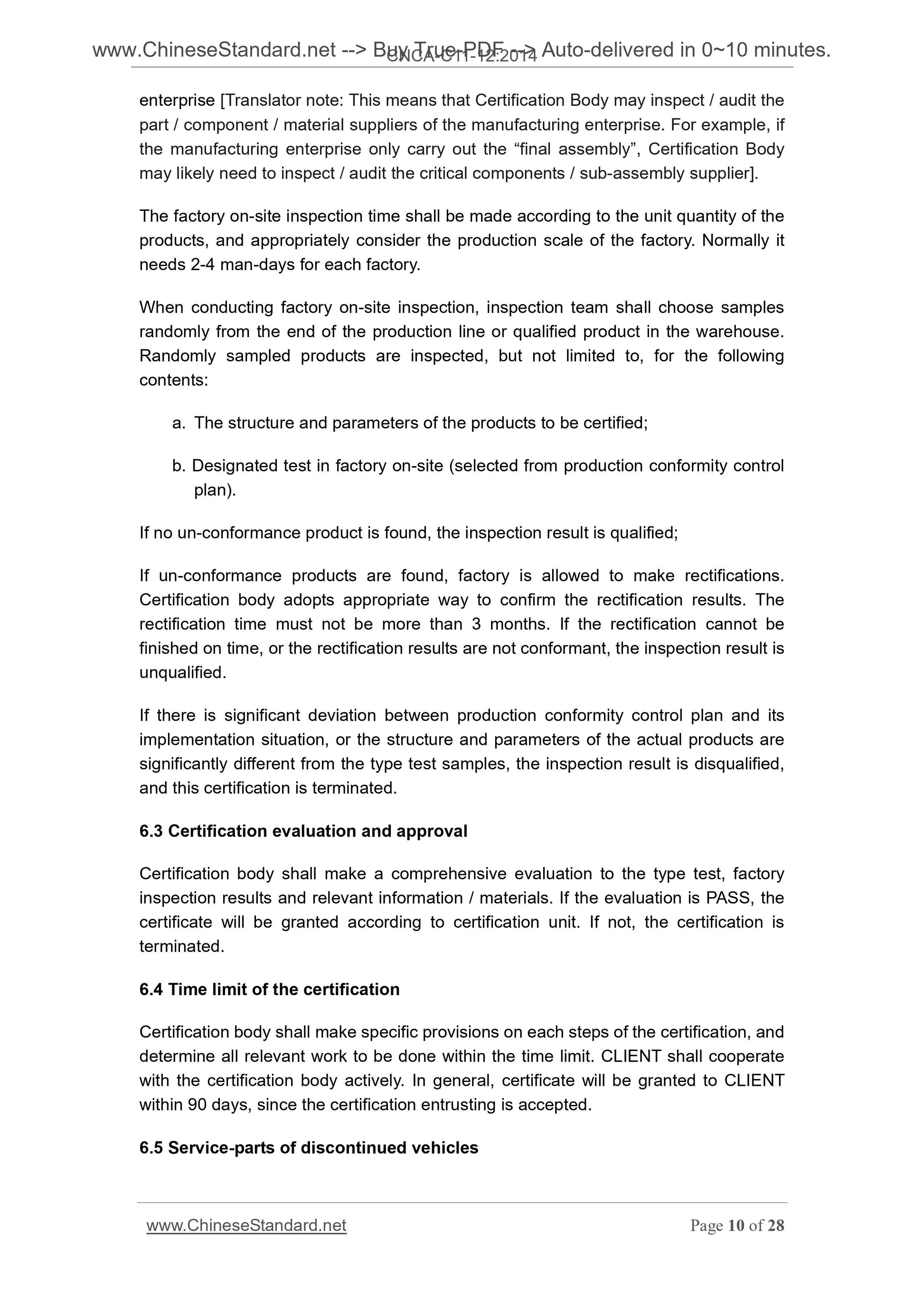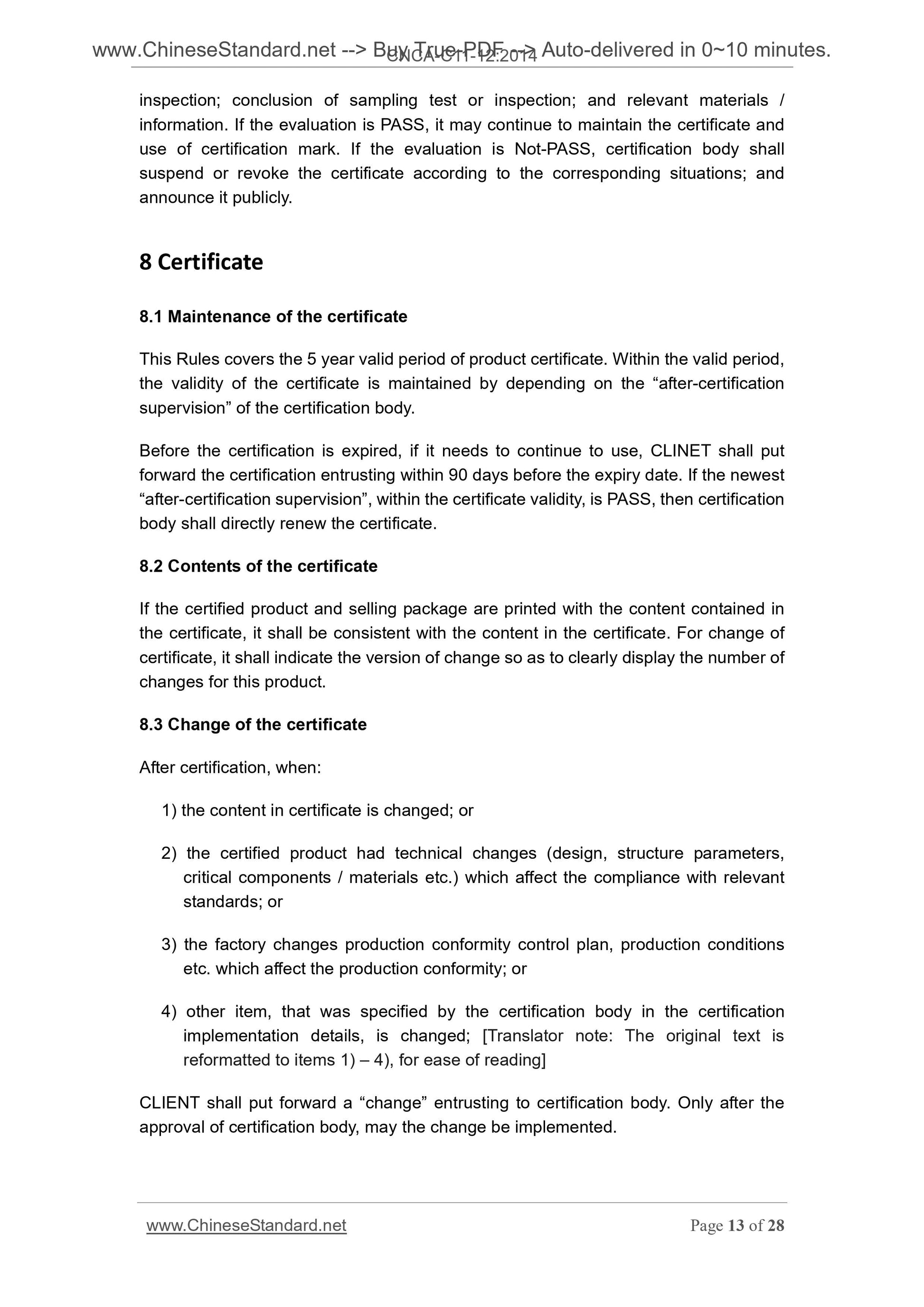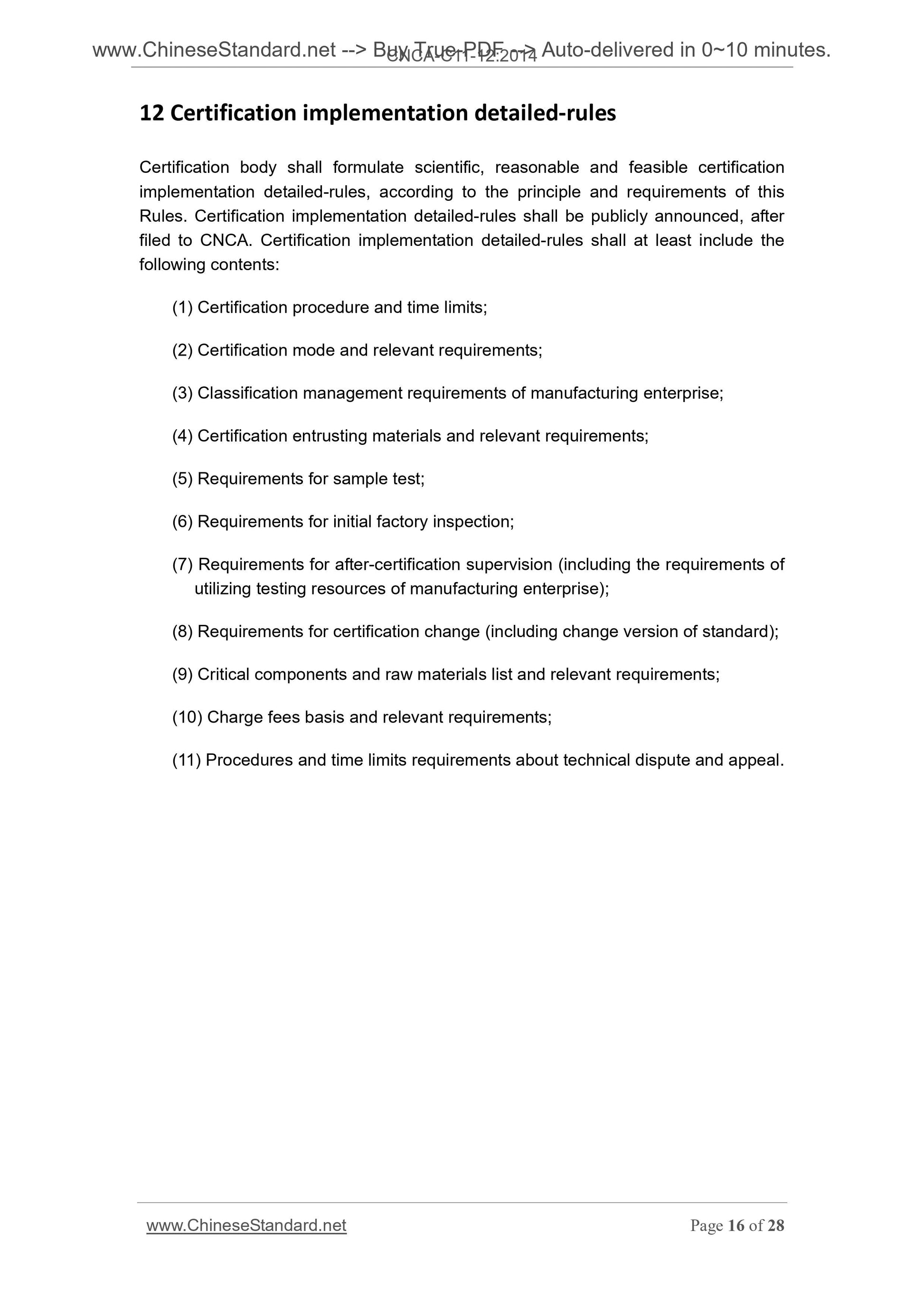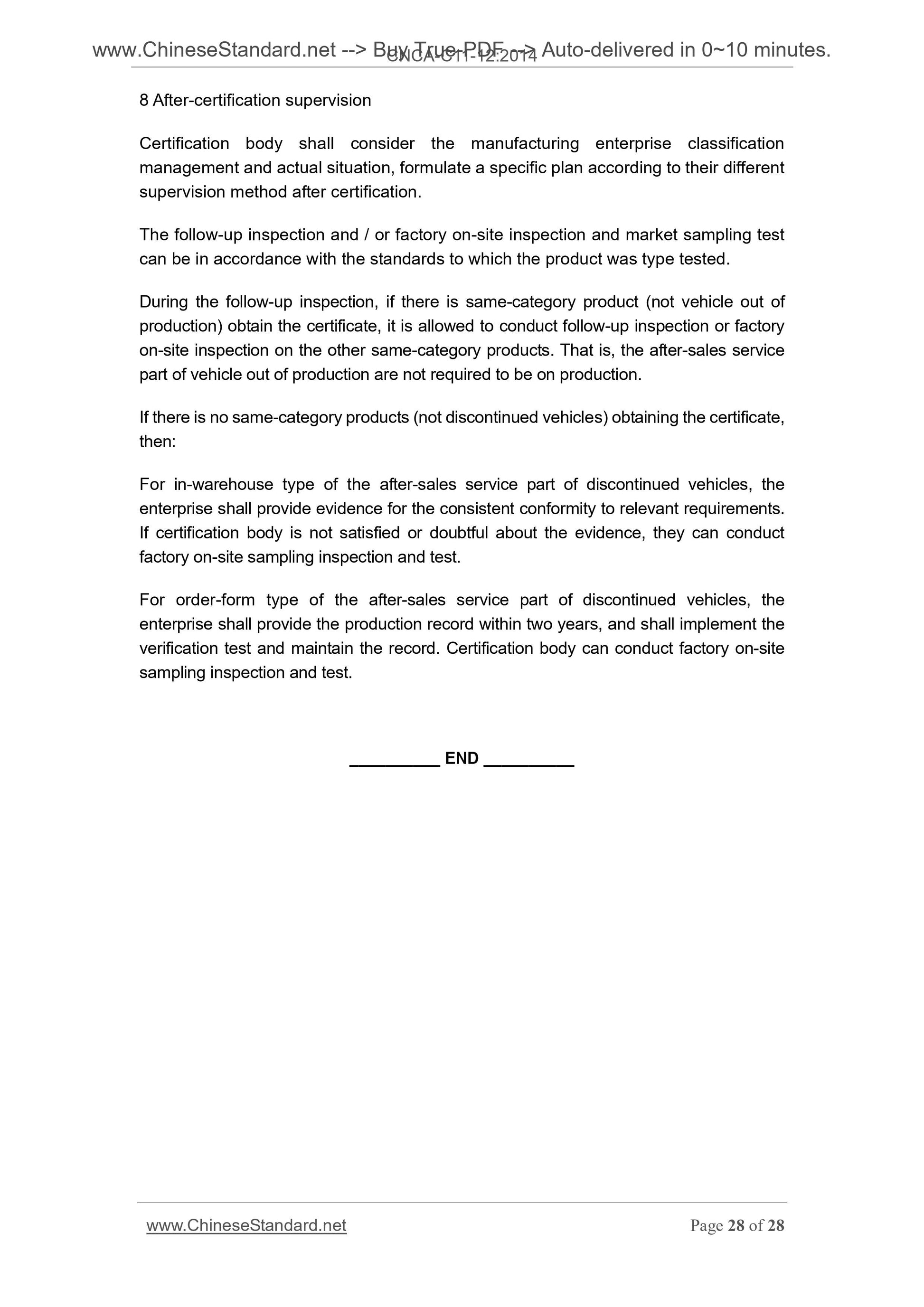1
/
su
11
PayPal, credit cards. Download editable-PDF and invoice in 1 second!
CNCA C11-12-2014 English PDF (CNCAC11-12-2014)
CNCA C11-12-2014 English PDF (CNCAC11-12-2014)
Prezzo di listino
$255.00 USD
Prezzo di listino
Prezzo scontato
$255.00 USD
Prezzo unitario
/
per
Spese di spedizione calcolate al check-out.
Impossibile caricare la disponibilità di ritiro
Delivery: 3 seconds. Download true-PDF + Invoice.
Get QUOTATION in 1-minute: Click CNCA C11-12-2014
Historical versions: CNCA C11-12-2014
Preview True-PDF (Reload/Scroll if blank)
CNCA C11-12-2014: China Compulsory Certification Implementation Rules - Vehicle seats and headrests
CNCA-C11-12.2014
CNCA / CCC
Serial No.. CNCA-C11-12.2014
CNCA-C11-12-2014
China Compulsory Certification Implementation Rules -
Vehicle seats and seat head restraints
ISSUED ON. AUGUST 21, 2014
IMPLEMENTED ON. JANUARY 01, 2015
Issued by. Certification and Accreditation Administration of the People's
Republic of China
He is now the Sales Manager (Founder and Managing Director) at
expertise and hands-on working experiences, through his then-employment as
“China Certification Program Manager” at BlackBerry Beijing, and “Product
Safety and Compliance (PS and C) Manager” at Motorola Singapore.
- CNCA / China Compulsory Certification (CCC) regulations.
- Hands-on program experience with regulator CNCA for CCC mark’s
compliance, approval and management.
- Was an authorized representative by then-employer BlackBerry (RIM)
to liaise with Chinese regulators, authorities, certification bodies and
designated laboratories – including CNCA, CQC, Beijing
Communication Authority, Beijing Administration of Quality Supervision
Inspection and Quarantine.
- Hands-on program experience with certification body CQC for
“certification entrusting”, type test, initial factory audit, regular / annual
factory audit (i.e. the “after-certification supervision” in this Rules).
- Manage, plan, guide and site-visit the global factories / suppliers’ global
factories (i.e. the “manufacturing enterprises” in this Rules) in North
America, Europe and China for CQC initial factory audit and regular
annual factory audit (after-certification supervision).
- ISO Process Auditor, certified by Motorola USA and Motorola Singapore
- PMP, certified by Project Management Institute USA.
Lead time to deliver. < 2 hours in office time; < 10 hours in off-office time.
Table of Contents
0 Introduction ... 4
1 Application scope ... 4
2 Certification standards ... 5
3 Certification modes ... 5
4 Classification of certification units ... 5
5 Certification entrusting ... 6
6 Certification implementation ... 7
7 After-certification supervision ... 11
8 Certificate ... 13
9 Certification marks ... 14
10 Charges ... 15
11 Certification responsibility ... 15
12 Certification implementation detailed-rules ... 16
Attachment 1. Compulsory classification of certification units of vehicle seats
and seat head restraints ... 17
Attachment 2. Production conformity requirements ... 19
Appendix 1. Factory quality assurance capability requirements ... 21
Attachment 3. Certification implementation of service parts for the after-sales
maintenance for discontinued vehicles ... 27
0 Introduction
This Rules is established based on the safety risk and certification risk of vehicle seats
and seat head restraints. It stipulates the basic principles and requirements for the
implementation of China Compulsory Certification for vehicle travelling data recorder.
This Rules can be used with other general rules issued by Certification and
Accreditation Administration (CNCA), such as “China Compulsory Certification
Implementation Rules - Manufacturing Enterprise Classification Management,
Certification Mode Selection and Determination”, “China Compulsory Certification
Implementation Rules - Utilization of Manufacturing Enterprise Testing Resource and
Other Certification Results”, “China Compulsory Certification Implementation Rules -
Factory Inspection General Requirements”.
The certification body shall make principles for certification according to the general
implementation rules and this Rules and implement them accordingly.
Manufacturing enterprise shall ensure that their certified products are capable of
sustaining the compliance with the certification and are compatible with the
requirements of the standards.
1 Application scope
This Rules applies to.
(1) M-, N-category vehicle seats;
(2) The head restraints used by above seats (if they are manufactured, sold or
imported independently).
But this Rules don’t apply to following seats and head restraints.
(1) Lateral seats, backward seats;
(2) The seats used by A-, I-class vehicles of M2-, M3-category;
(3) Seats or restraining devices for child occupants.
Due to the changes in the laws, regulations or related product standards, technology,
industry policies and other causes which may change the applicable scope, the
announcement released by CNCA shall be final and conclusive.
When it does not comply with national laws and regulations AND relevant industry
policies, the certification body must not accept the certification entrusting.
5.2 Application materials
The certification body shall, in accordance with the laws and regulations, standards
and other requirements, specify the checklist of application materials in the
implementation detailed-rules. It shall at least includes certification application form or
contract, registration certificates of the CLIENT and manufacturer, “Product
description of vehicle seats and seat head restraints” (Attachment 1), “Production
conformity control plan” (compile according to Attachment 2), etc.
CLIENT shall provide the required materials according to the requirements of
application material checklist in certification implementation detailed-rules.
Certification body is responsible for auditing, managing, preserving and keeping
confidential of the relevant materials, and shall inform the CLIENT of the auditing
results.
5.3 Implementation Arrangement
Certification body shall agree with the CLIENT on the relevant responsibilities and
arrangement of various aspects of certification implementation. And according to the
situation of manufacturing enterprise and classification management AND the
requirements of this Rules and certification implementation detailed-rules,
DETERMINE the specific program of certification implementation and INFORM
CLIENT.
6 Certification implementation
6.1 Type test
6.1.1 Type test plan
Certification body shall formulate the type test plan, after auditing the materials. And
INFORM the CLIENT. CLIENT may voluntarily select the designated laboratory.
Type test plan includes all samples’ requirements and quantity, test standard items,
laboratory information etc.
6.1.2 Sample requirements of type test
In general, according to the requirements of certification body, samples of type test
shall be submitted by the CLIENT with representative samples for test. When
necessary, certification body may adopt on-site sampling / seal-samples method to
obtain the samples.
enterprise [Translator note. This means that Certification Body may inspect / audit the
part / component / material suppliers of the manufacturing enterprise. For example, if
the manufacturing enterprise only carry out the “final assembly”, Certification Body
may likely need to inspect / audit the critical components / sub-assembly supplier].
The factory on-site inspection time shall be made according to the unit quantity of the
products, and appropriately consider the production scale of the factory. Normally it
needs 2-4 man-days for each factory.
When conducting factory on-site inspection, inspection team shall choose samples
randomly from the end of the production line or qualified product in the warehouse.
Randomly sampled products are inspected, but not limited to, for the following
contents.
a. The structure and parameters of the products to be certified;
b. Designated test in factory on-site (selected from production conformity control
Get QUOTATION in 1-minute: Click CNCA C11-12-2014
Historical versions: CNCA C11-12-2014
Preview True-PDF (Reload/Scroll if blank)
CNCA C11-12-2014: China Compulsory Certification Implementation Rules - Vehicle seats and headrests
CNCA-C11-12.2014
CNCA / CCC
Serial No.. CNCA-C11-12.2014
CNCA-C11-12-2014
China Compulsory Certification Implementation Rules -
Vehicle seats and seat head restraints
ISSUED ON. AUGUST 21, 2014
IMPLEMENTED ON. JANUARY 01, 2015
Issued by. Certification and Accreditation Administration of the People's
Republic of China
He is now the Sales Manager (Founder and Managing Director) at
expertise and hands-on working experiences, through his then-employment as
“China Certification Program Manager” at BlackBerry Beijing, and “Product
Safety and Compliance (PS and C) Manager” at Motorola Singapore.
- CNCA / China Compulsory Certification (CCC) regulations.
- Hands-on program experience with regulator CNCA for CCC mark’s
compliance, approval and management.
- Was an authorized representative by then-employer BlackBerry (RIM)
to liaise with Chinese regulators, authorities, certification bodies and
designated laboratories – including CNCA, CQC, Beijing
Communication Authority, Beijing Administration of Quality Supervision
Inspection and Quarantine.
- Hands-on program experience with certification body CQC for
“certification entrusting”, type test, initial factory audit, regular / annual
factory audit (i.e. the “after-certification supervision” in this Rules).
- Manage, plan, guide and site-visit the global factories / suppliers’ global
factories (i.e. the “manufacturing enterprises” in this Rules) in North
America, Europe and China for CQC initial factory audit and regular
annual factory audit (after-certification supervision).
- ISO Process Auditor, certified by Motorola USA and Motorola Singapore
- PMP, certified by Project Management Institute USA.
Lead time to deliver. < 2 hours in office time; < 10 hours in off-office time.
Table of Contents
0 Introduction ... 4
1 Application scope ... 4
2 Certification standards ... 5
3 Certification modes ... 5
4 Classification of certification units ... 5
5 Certification entrusting ... 6
6 Certification implementation ... 7
7 After-certification supervision ... 11
8 Certificate ... 13
9 Certification marks ... 14
10 Charges ... 15
11 Certification responsibility ... 15
12 Certification implementation detailed-rules ... 16
Attachment 1. Compulsory classification of certification units of vehicle seats
and seat head restraints ... 17
Attachment 2. Production conformity requirements ... 19
Appendix 1. Factory quality assurance capability requirements ... 21
Attachment 3. Certification implementation of service parts for the after-sales
maintenance for discontinued vehicles ... 27
0 Introduction
This Rules is established based on the safety risk and certification risk of vehicle seats
and seat head restraints. It stipulates the basic principles and requirements for the
implementation of China Compulsory Certification for vehicle travelling data recorder.
This Rules can be used with other general rules issued by Certification and
Accreditation Administration (CNCA), such as “China Compulsory Certification
Implementation Rules - Manufacturing Enterprise Classification Management,
Certification Mode Selection and Determination”, “China Compulsory Certification
Implementation Rules - Utilization of Manufacturing Enterprise Testing Resource and
Other Certification Results”, “China Compulsory Certification Implementation Rules -
Factory Inspection General Requirements”.
The certification body shall make principles for certification according to the general
implementation rules and this Rules and implement them accordingly.
Manufacturing enterprise shall ensure that their certified products are capable of
sustaining the compliance with the certification and are compatible with the
requirements of the standards.
1 Application scope
This Rules applies to.
(1) M-, N-category vehicle seats;
(2) The head restraints used by above seats (if they are manufactured, sold or
imported independently).
But this Rules don’t apply to following seats and head restraints.
(1) Lateral seats, backward seats;
(2) The seats used by A-, I-class vehicles of M2-, M3-category;
(3) Seats or restraining devices for child occupants.
Due to the changes in the laws, regulations or related product standards, technology,
industry policies and other causes which may change the applicable scope, the
announcement released by CNCA shall be final and conclusive.
When it does not comply with national laws and regulations AND relevant industry
policies, the certification body must not accept the certification entrusting.
5.2 Application materials
The certification body shall, in accordance with the laws and regulations, standards
and other requirements, specify the checklist of application materials in the
implementation detailed-rules. It shall at least includes certification application form or
contract, registration certificates of the CLIENT and manufacturer, “Product
description of vehicle seats and seat head restraints” (Attachment 1), “Production
conformity control plan” (compile according to Attachment 2), etc.
CLIENT shall provide the required materials according to the requirements of
application material checklist in certification implementation detailed-rules.
Certification body is responsible for auditing, managing, preserving and keeping
confidential of the relevant materials, and shall inform the CLIENT of the auditing
results.
5.3 Implementation Arrangement
Certification body shall agree with the CLIENT on the relevant responsibilities and
arrangement of various aspects of certification implementation. And according to the
situation of manufacturing enterprise and classification management AND the
requirements of this Rules and certification implementation detailed-rules,
DETERMINE the specific program of certification implementation and INFORM
CLIENT.
6 Certification implementation
6.1 Type test
6.1.1 Type test plan
Certification body shall formulate the type test plan, after auditing the materials. And
INFORM the CLIENT. CLIENT may voluntarily select the designated laboratory.
Type test plan includes all samples’ requirements and quantity, test standard items,
laboratory information etc.
6.1.2 Sample requirements of type test
In general, according to the requirements of certification body, samples of type test
shall be submitted by the CLIENT with representative samples for test. When
necessary, certification body may adopt on-site sampling / seal-samples method to
obtain the samples.
enterprise [Translator note. This means that Certification Body may inspect / audit the
part / component / material suppliers of the manufacturing enterprise. For example, if
the manufacturing enterprise only carry out the “final assembly”, Certification Body
may likely need to inspect / audit the critical components / sub-assembly supplier].
The factory on-site inspection time shall be made according to the unit quantity of the
products, and appropriately consider the production scale of the factory. Normally it
needs 2-4 man-days for each factory.
When conducting factory on-site inspection, inspection team shall choose samples
randomly from the end of the production line or qualified product in the warehouse.
Randomly sampled products are inspected, but not limited to, for the following
contents.
a. The structure and parameters of the products to be certified;
b. Designated test in factory on-site (selected from production conformity control
Share
